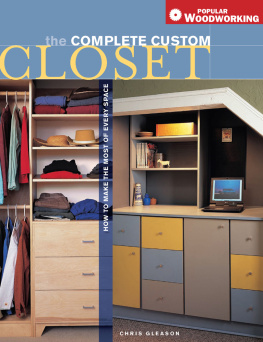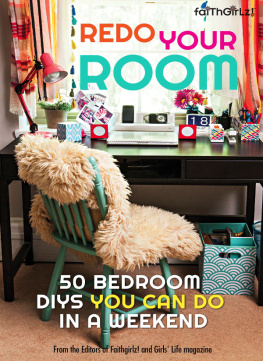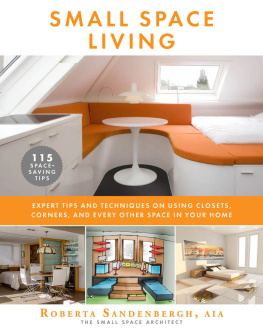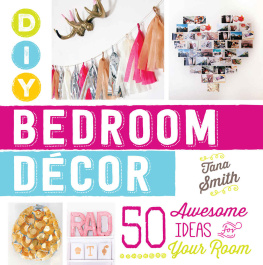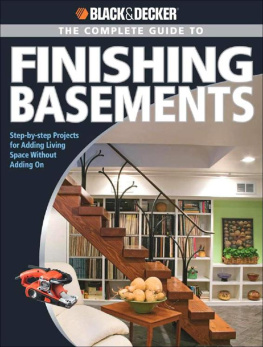the COMPLETE CUSTOM CLOSET
CHRIS GLEASON
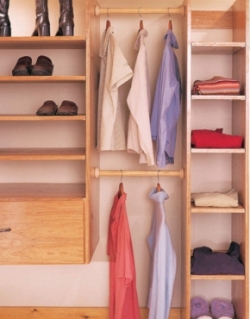

THE COMPLETE CUSTOM CLOSET. COPYRIGHT 2006 by Chris Gleason. Printed and bound in China. All rights reserved. No part of this book may be reproduced in any form or by any electronic or mechanical means including information storage and retrieval systems without permission in writing from the publisher, except by a reviewer, who may quote brief passages in a review. Published by Popular Woodworking Books, an imprint of F+W Publications, Inc., 4700 East Galbraith Road, Cincinnati, Ohio, 45236. First edition.
Distributed in Canada by Fraser Direct
100 Armstrong Avenue
Georgetown, Ontario L7G 5S4
Canada
Distributed in the U.K. and Europe by David & Charles
Brunel House
Newton Abbot
Devon TQ12 4PU
England
Tel: (+44) 1626 323200
Fax: (+44) 1626 323319
E-mail: postmaster@davidandcharles.co.uk
Distributed in Australia by Capricorn Link
P.O. Box 704
Windsor, NSW 2756
Australia
Visit our Web site at www.popularwoodworking.com for information on more resources for woodworkers.
Other fine Popular Woodworking Books are available from your local bookstore or direct from the publisher.
10 09 08 07 06 5 4 3 2 1
Library of Congress Cataloging-in-Publication Data
Gleason, Chris, 1973
Closet / by Chris Gleason. 1st ed.
p. cm.
Includes bibliographical references and index.
ISBN-13: 978-1-55870-777-1 (alk. paper)
eISBN-13: 978-1-4403-1609-8
ISBN-10: 1-55870-777-8 (alk. paper)
1. Cabinetwork. 2. Clothes closets. I. Title.
TT197.G487 2006
684.1'6 dc22
2006015861
Acquisitions editor: Jim Stack
Editor: Amy Hattersley
Designer: Brian Roeth
Production coordinator: Jennifer L. Wagner
Step-by-step photographer: Chris Gleason
Chapter opener photographer: Richer Images
Technical illustrator: Len Churchill

METRIC CONVERSION CHART
to convert | to | multiply by |
Inches | Centimeters | 2.54 |
Centimeters | Inches | 0.4 |
Feet | Centimeters | 30.5 |
Centimeters | Feet | 0.03 |
Yards | Meters | 0.9 |
Meters | Yards | 1.1 |
READ THIS IMPORTANT SAFETY NOTICE
To prevent accidents, keep safety in mind while you work. Use the safety guards installed on power equipment; they are for your protection. When working on power equipment, keep fingers away from saw blades, wear safety goggles to prevent injuries from flying wood chips and saw-dust, wear headphones to protect your hearing, and consider installing a dust vacuum to reduce the amount of airborne sawdust in your woodshop. Don't wear loose clothing, such as neckties or shirts with loose sleeves, or jewelry, such as rings, necklaces or bracelets, when wor-ing on power equipment. Tie back long hair to prevent it from getting caught in your equipment. People who are sensitive to certain chemicals should check the chemical content of any product before using it. The authors and editors who compiled this book have tried to make the contents as accurate and correct as possible. Plans, illustrations, photographs and text have been carefully checked. All instructions, plans and projects should be carefully read, studied and understood before beginning construction. Due to the variability of local conditions, construction materials, skill levels, etc., neither the author nor Popular Woodworking Books assumes any responsibility for any accidents, injuries, damages or other losses incurred resulting from the material presented in this book. Prices listed for supplies and equipment were current at the time of publication and are subject to change. Glass shelving should have all edges polished and must be tempered. Untempered glass shelves may shatter and can cause serious bodily injury. Tempered shelves are very strong and if they break will just crumble, minimizing personal injury.
ABOUT THE AUTHOR

A self-taught woodworker, Chris Gleason has operated Gleason Woodworking Studio for more than eight years. From his studio in Salt Lake City, Utah, he designs and builds contemporary furniture and cabinetry for a variety of settings. When he's not in the shop, he enjoys mountain biking in the summertime and telemark skiing in the winter. He is also an enthusiastic old-time banjo and fiddle player.
ACKNOWLEDGEMENTS
I'm grateful to Jim Stack and Amy Hattersley at F+W Publications for helping so much to bring this book to life. I'd also like to thank my friends and clients who opened up their homes for the closets you'll see in this book: Their willingness to get involved made for some neat projects. While I'm at it, my wife, Michele, also deserves more than a little acknowledgement for her good nature and patience.
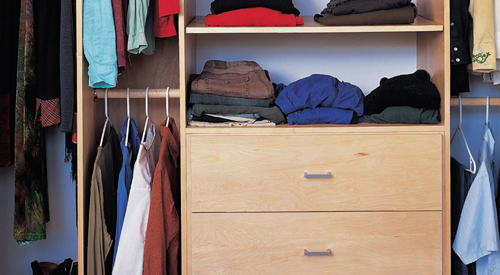
introduction
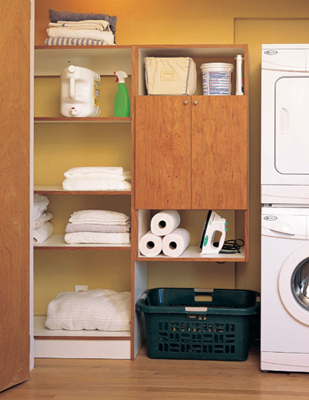
IT SEEMS LIKE EVERYONE I KNOW HAS MORE STUFF THAN THEY DO SPACE TO STORE IT IN. AND for those lucky few who actually have enough space, a lack of proper layout and organization usually lead to limited functionality and diminished aesthetic appeal. Given the vast number of companies that can design and provide stylish closet solutions, it is easy to overcome this hurdle, but not without creating another one: cost. The nicest closet systems, the ones you would happily welcome into your home, generally come with corresponding high price tags. Given the amount of potential usefulness these units offer over their lifetimes, the prices may well be justified, but for those of us who are inclined to do it ourselves, closets represent a great opportunity to save a great deal of money and to add value to our homes.
This book is intended for beginner and intermediate woodworkers who are interested in designing and building custom closets at a reasonable cost. The first part will present some general concepts that aid in planning effective storage. The book is essentially a set of case studies. I began by making a list of the types of closets most people tend to have. Then I chose a real-life example of each and designed an organizer for each one. Each project presents one of these closet types in detail with step-by-step construction photos and a special section to highlight useful techniques or concepts.
Because each individual's lifestyle and storage needs are unique, and because we're usually working with spaces that defy a one-size-fits-all approach, the ideas presented in this book are meant to be modified and improved upon as you see fit. Far from being the final word on the subject, this book is meant to provide design inspiration and practical methods to incorporate as you create the best possible solutions to your own storage needs.

